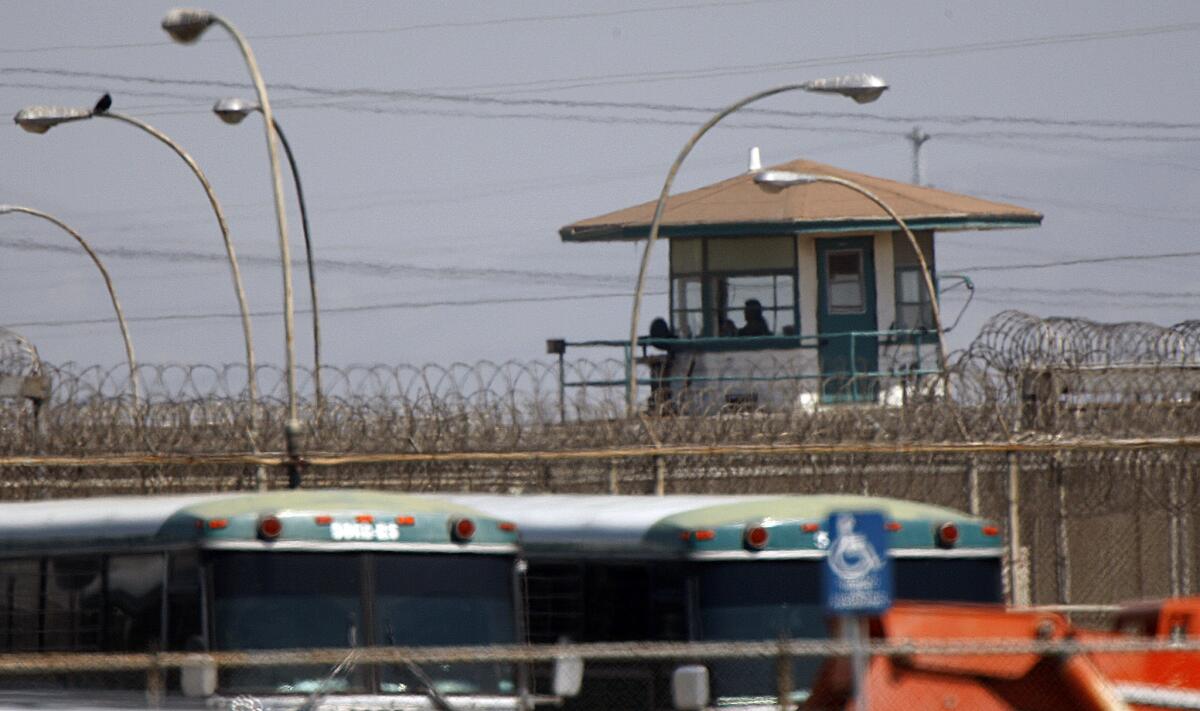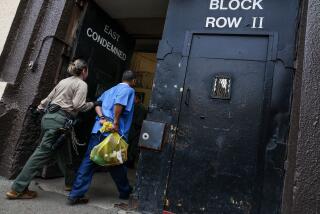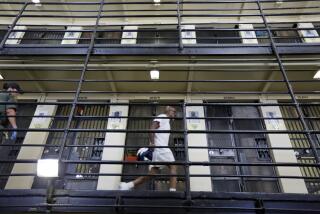‘I don’t deserve a death sentence’: Coronavirus outbreaks bring fear inside California prisons

- Share via
John Blagg says the sound of coughing echoes through Spruce Hall at the California Institution for Men in Chino as he and other inmates lay in their beds.
Six months ago, the coughing wouldn’t have meant much in this dormitory, where many inmates like him have a myriad of medical conditions. Blagg says he’s survived three heart attacks, two strokes, seven stents, among other medical setbacks.
But now, he says it is a constant reminder of the coronavirus that has crept into the Chino prison. At least 81 inmates have tested positive, one died Sunday and 29 correctional staffers have been infected.
Blagg says he remains in close quarters with his fellow inmates, including one who sleeps on the rack just 2 feet above him. “People are coughing, constantly coughing,” he said in a phone interview from the prison this week. “There is no way to social distance.
Blagg said several inmates in his dormitory with COVID-19 symptoms have been placed in isolation and some were taken to San Bernardino County hospitals.
Blagg is serving an eight-year sentence for driving under the influence while causing injury to a passenger. It is a sentence, he said, he deserved for his foolish deeds.
“I don’t deserve a death sentence,” he said. “I am afraid I am not going to make it out...I understand I did what I did. I’ll do my time. I don’t want to die and I don’t want other people to die.”
Blagg is eligible for parole in 2024, records show.
California Department of Corrections and Rehabilitation officials would not comment on the conditions in Blagg’s unit.
“To allow Department staff to focus on addressing our COVID-19 preparedness and response efforts, we are not able to respond to individual requests regarding (the) status of a particular housing unit within a specific institution,” corrections spokeswoman Dana Simas wrote in an email.
At least three inmates released from the prison in recent weeks tested positive for COVID-19, according to public health officials.
One of those inmates, Joe Anderson, a 32-year-old convicted forger, tested positive within six days of being released April 8 from Spruce, igniting a furor in Northern California over why he was allowed to leave the prison.
“I am symptomatic. So God knows how many others in there with John already have it,” Anderson said from a Best Western hotel in Ukiah, where local authorities have housed and fed him since Mendocino County Public Health tested him.
Anderson was one of about 3,500 inmates released before their scheduled release date under a plan announced by Gov. Gavin Newsom to help reduce crowding in prisons during the pandemic. Anderson said that under the governor’s directive, his release date was changed from May to April.
Mendocino County Sheriff Matt Kendall has publicly questioned why the California Department of Corrections released Anderson, who following his release traveled 500 miles north — stopping by stores along the way — given he came from a quarantined part of the prison.
Simas, in her response to questions from The Times, said the department follows “our local public health notification requirements laid out in our clinical guidance ... which requires local public health department notifications for those released from quarantined units or positive COVID-19 cases.”
In this case, the inmate — whom the department did not name — was supposed to go to Stanislaus County, and probation and public health officials were notified, CDCR said in a statement. Stanislaus County Probation then allowed the inmate to travel to Mendocino County, the statement noted.
Simas on Friday told The Times that the Chino prison was “working hard to develop a process to test every inmate being released after serving their full-term as defined by law.” She said the department is working with lab vendors and hopes to begin such tests within the next week.
Another inmate, Ronald Walker, was released April 3 to a Compton halfway house. Within eight days, he died of respiratory issues after testing positive for coronavirus. The L.A. County coroner has deferred a cause of death. A third man who would test positive was released to Lake County in Northern California, according to officials there.
On Sunday, officials revealed a 60-year-old inmate from the Chino facility died after being hospitalized with COVID-19. The inmate had been quarantined in a dorm with other inmates, according to federal court filings, but his symptoms took a turn for the worse on April 16 and he was taken to a hospital, where he died three days later.
Blagg, 57, said the news of the first death traveled quickly through the dorms, where the fear is pervasive. Inmate temperatures are taken twice a day. Anyone registering a body temperature of more than 100 degrees is sent to coronavirus positive isolation.
Sanitation is a struggle, Blagg said. Only a handful of the sinks and showers work, he said, reflecting descriptions by lawyers for the inmates in recent federal case filings seeking a mass release of California’s incarcerated and a plan to socially distance those still in custody.
He said each inmate was given three cloth masks. Sanitation stations set up in an outside courtyard quickly ran out of cleaning fluids, he added.
To prevent the potential spread of the virus, Blagg said the CPAP machines that he and other inmates use for sleep apnea have been disconnected in the dorm. His machine helps him cope with chronic obstructive pulmonary disease, he said.
On Wednesday morning, about 130 crowded into the dormitory and Blagg said the prison is setting up tents for inmates outside. Corrections officials announced Thursday those tents will house about 60 inmates.
Blagg and Anderson say they can’t understand why corrections officials have not tested all the inmates at Chino, especially now that Newsom this week has proposed expanding testing to those without symptoms in high-risk settings. Anderson said if the governor thinks people in nursing homes should be tested, then surely inmates and staff in a coronavirus hot spot such as the Chino prison should be too.
According to the corrections department, 138 of the Chino prison’s 3,367 inmates have been tested, with more than 50% of them positive. Statewide, as of Friday, 166 inmates and 113 staff have tested positive inside California’s prisons.
Simas said the department is “working diligently to implement the guidance for congregate living facilities issued by California Department of Public Health by expanding our testing to include mass testing at institutions, point-of-care rapid response testing, and other testing strategies to help us protect all those who live and work in our state prisons.” She pointed out that last week, more than 100 inmates at California State Prison, Los Angeles County were tested.
Attorneys litigating on behalf of inmates since the pandemic started have attempted to force the state to release more prisoners or move them into other forms of detention to reduce overcrowding and allow for social distancing that can slow the spread of the virus.
A three-judge federal panel rejected efforts to release more prisoners. Last week, a federal judge denied an emergency motion to make the state develop a plan to further reduce the inmate population, saying prison officials were making efforts to spread out prisoners and protect them as best as possible.
A lawyer for the state told the judge it was adhering to a federal receiver’s recommendation to create social distancing inside prison dorms statewide by arranging beds in groups of eight. These “pods” are to be separated by the recommended 6 feet of space.
Blagg said a row of bunks was briefly removed from his dorm as a way to spread out the sleeping arrangement. He said officials took photographs of the new layout, but that inmates never got to use the new arrangement because the row of bunks was brought back in.
Attorney Donald Specter of the Prison Law Office in Berkeley, which has litigated cases against the state for overcrowding and medical care, said attorneys have been unable to see conditions in the prisons to independently verify conditions and changes since the pandemic began.
Addressing U.S. District Judge Jon Tigar last week, attorney Alison Hardy acknowledged that the virus had not spread throughout the 35 state prisons, but she feared they are a “tinder box,” as they are large institutional settings filled with medically vulnerable people.
Some 45,000 of California’s 110,000 inmates suffer from an underlying medical condition that makes them vulnerable to coronavirus infection.
Anderson, who was released April 8, said everyone including the correctional officers is aware they really don’t know who has the virus. “There is a false sense of security. Clearly, you are mingling with people in there like me who show no symptoms of the virus,” he said.
More to Read
Sign up for Essential California
The most important California stories and recommendations in your inbox every morning.
You may occasionally receive promotional content from the Los Angeles Times.











